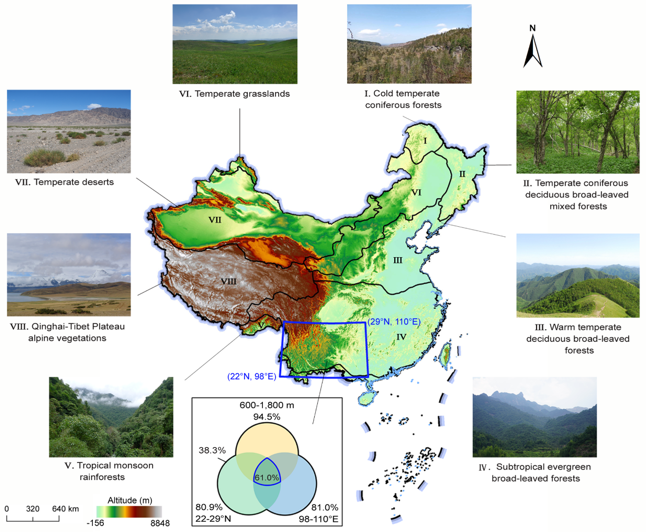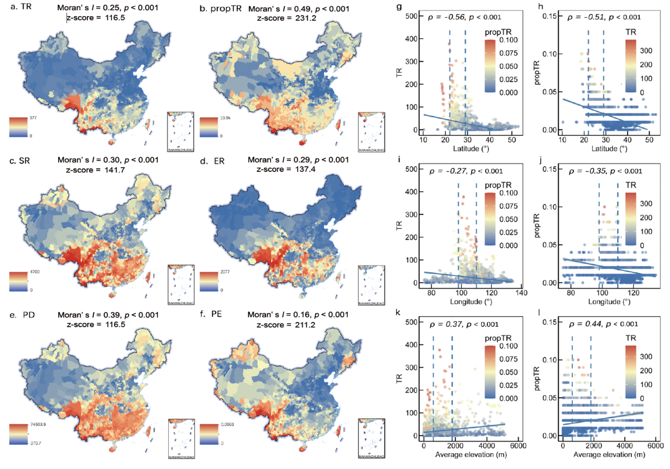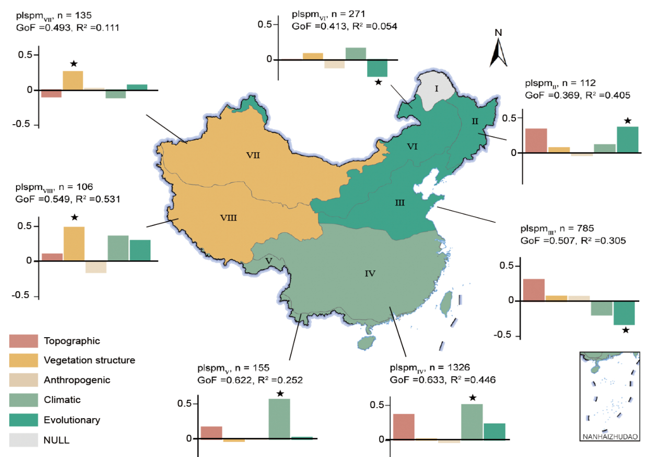Understanding the spatial characteristics of extinction risks and underlying driving is crucial for biodiversity conservation and sustainability. A recent study published in Nature Communications has revealed spatial concentration and extent-dependent drivers of extinction risk for flowering plants in China.
China possesses highly heterogeneous topography, diverse climatic conditions, varied ecological environments, and exceptionally high biodiversity. However, biodiversity in China is under threat, with a significant proportion of species at high risk of extinction. Considering the heterogeneous topography and diverse vegetation associations in China, the spatial heterogeneity of extinction risk requires examination in more detail.
Prof. Zhiduan Chen’s research team from the Institute of Botany, Chinese Academy of Sciences (CAS) utilized 2.02 million fine-grained distribution records and a robust phylogeny encompassing 27,185 species and identified that the extinction risk of flowering plants is concentrated in southwestern China.
The study further reveals that the extinction risks of flowering plants in China are driven by multiple factors. At the national extent, vegetation structure based on proportion of growth forms is likely the dominant extinction driver, followed by climatic and evolutionary drivers.
Finer extent analyses indicate that dominant extinction drivers vary across zones and vegetation regions, suggesting that spatial extinction risks of flowering plants in China are extent dependent. Despite regional heterogeneity, researchers detected a geographical continuity potential in extinction drivers, with West China's variation dominated by vegetation structure, South China by climate, and North China by evolution. The findings underscore the importance of considering spatial scale and extent effects in the assessment of extinction risks.
This study was supported by the National Natural Science Foundation of China, the National Key Research Development Program of China, and the Youth Innovation Promotion Association of CAS, etc.
Contact
Limin Lu
E-mail: liminlu@ibcas.ac.cn
Zhiduan Chen
E-mail: zhiduan@ibcas.ac.cn
URL: https://www.nature.com/articles/s41467-024-50704-3
DOI: https://doi.org/10.1038/s41467-024-50704-3

Topography and major vegetation regions in China, highlighting spatial concentration of threatened plants. (Image by IBCAS)

Spatial distribution patterns of different diversity measures for flowering plants in China. (Image by IBCAS)

Spatial threatening processes and potential extinction drivers of flowering plants in different vegetation regions based on regional-plspms (Image by IBCAS)
Understanding the spatial characteristics of extinction risks and underlying driving is crucial for biodiversity conservation and sustainability. A recent study published in Nature Communications has revealed spatial concentration and extent-dependent drivers of extinction risk for flowering plants in China.
China possesses highly heterogeneous topography, diverse climatic conditions, varied ecological environments, and exceptionally high biodiversity. However, biodiversity in China is under threat, with a significant proportion of species at high risk of extinction. Considering the heterogeneous topography and diverse vegetation associations in China, the spatial heterogeneity of extinction risk requires examination in more detail.
Prof. Zhiduan Chen’s research team from the Institute of Botany, Chinese Academy of Sciences (CAS) utilized 2.02 million fine-grained distribution records and a robust phylogeny encompassing 27,185 species and identified that the extinction risk of flowering plants is concentrated in southwestern China.
The study further reveals that the extinction risks of flowering plants in China are driven by multiple factors. At the national extent, vegetation structure based on proportion of growth forms is likely the dominant extinction driver, followed by climatic and evolutionary drivers.
Finer extent analyses indicate that dominant extinction drivers vary across zones and vegetation regions, suggesting that spatial extinction risks of flowering plants in China are extent dependent. Despite regional heterogeneity, researchers detected a geographical continuity potential in extinction drivers, with West China's variation dominated by vegetation structure, South China by climate, and North China by evolution. The findings underscore the importance of considering spatial scale and extent effects in the assessment of extinction risks.
This study was supported by the National Natural Science Foundation of China, the National Key Research Development Program of China, and the Youth Innovation Promotion Association of CAS, etc.
Contact
Limin Lu
E-mail: liminlu@ibcas.ac.cn
Zhiduan Chen
E-mail: zhiduan@ibcas.ac.cn
URL: https://www.nature.com/articles/s41467-024-50704-3
DOI: https://doi.org/10.1038/s41467-024-50704-3

Topography and major vegetation regions in China, highlighting spatial concentration of threatened plants. (Image by IBCAS)

Spatial distribution patterns of different diversity measures for flowering plants in China. (Image by IBCAS)

Spatial threatening processes and potential extinction drivers of flowering plants in different vegetation regions based on regional-plspms (Image by IBCAS)
